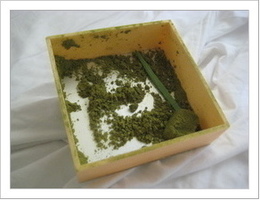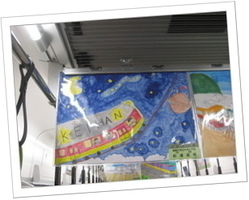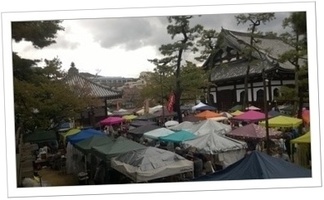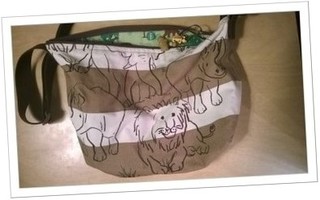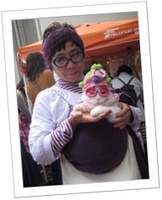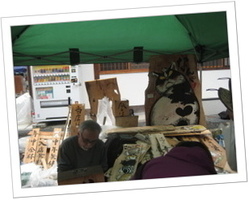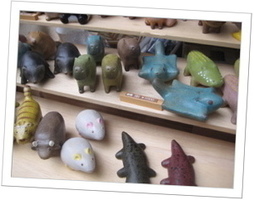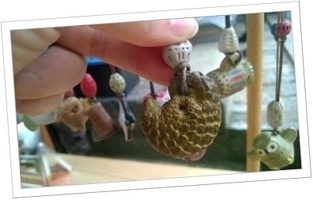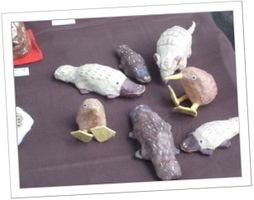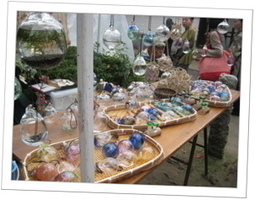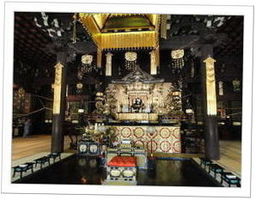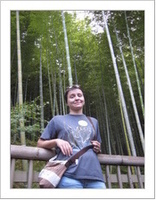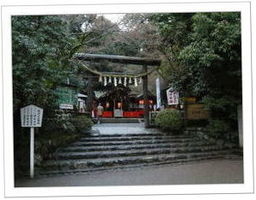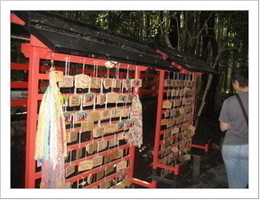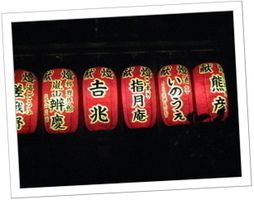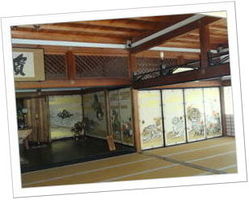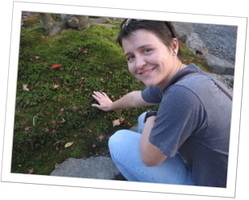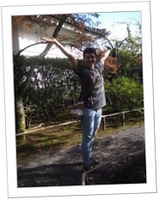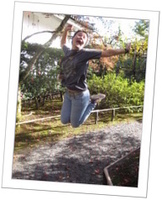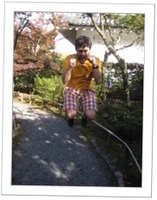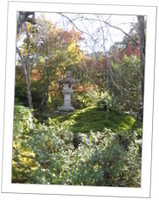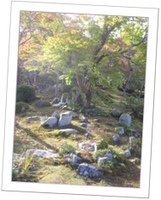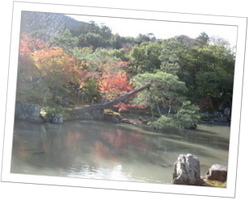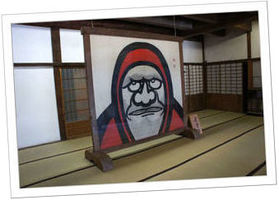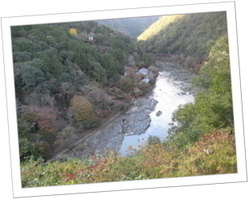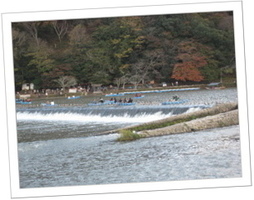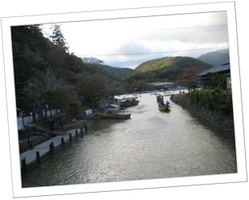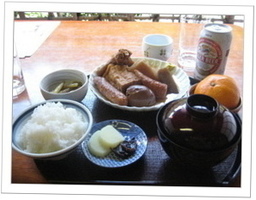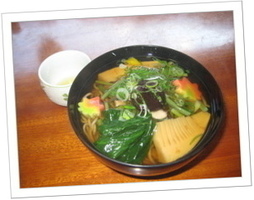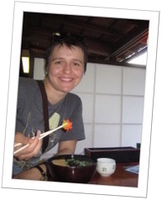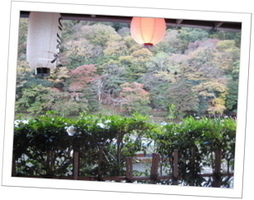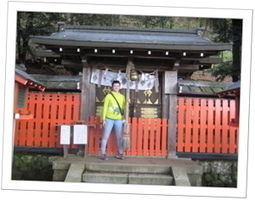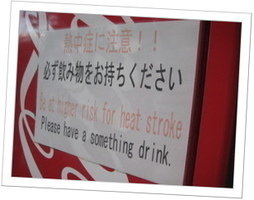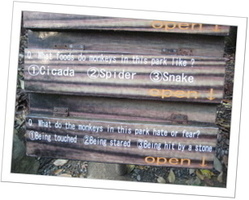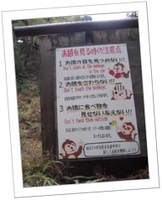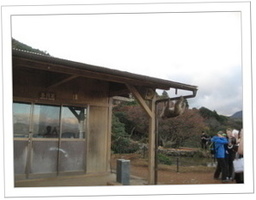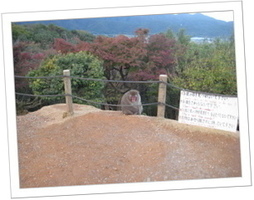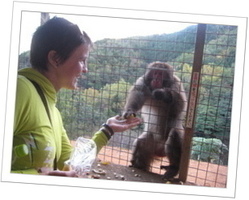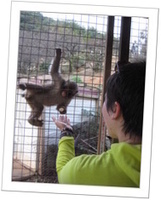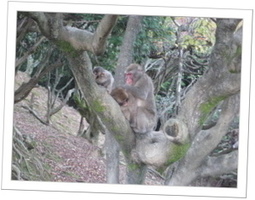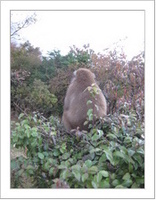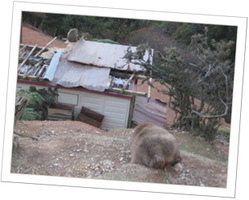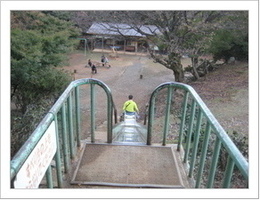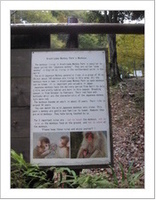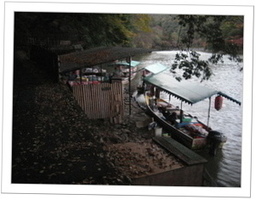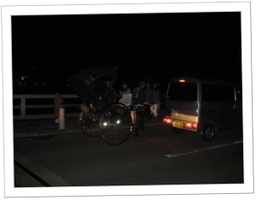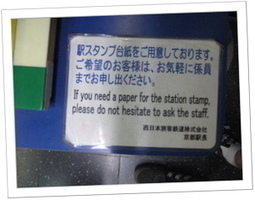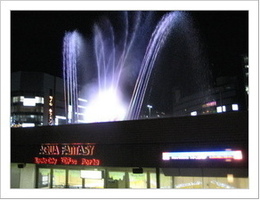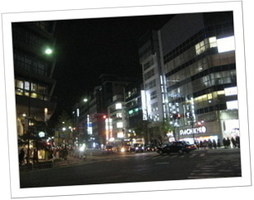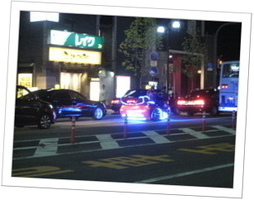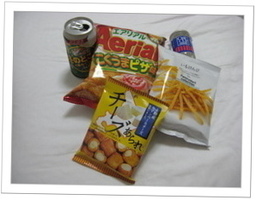Japan Day 7: “Don’t Stare at the Monkeys in the Eye”
 July 2, 2016
by
David T. Allen
July 2, 2016
by
David T. Allen
It was hard to believe we had another week in Kyoto, but there was still a lot to do. In this article, I cover a monthly handcraft market held on temple grounds, shrines nestled in the bamboo grove of Arashiyama, boats and rickshaws along the Hozu-gawa River, and a mountain park crawling with monkeys.
We breakfasted on the warabimochi purchased the prior day at Nishiki Market.
The matcha powder was a welcome pick-me-up. After watching me lick it off my finger, Leslie said, “Rub it on your gums like cocaine!”
We were wired. I wanted to pour hot water on it and drink what was left.
Most pictures were taken on Sunday, November 15, 2015.
Handcraft Market at Chion-ji
Our hostel, Backpacker K’s House Kyoto, maintained a list of events in the area. The only one we could attend was the Hand Craft Market at Chion-ji. This was an exciting opportunity, as Chion-ji was already on our to-see list.
It smelled of mud, incense, coffee, and sweets. The rain from the prior day made it messy, so cardboard was laid over the paths.
Leslie spotted a bag with rhino and elephant fabric. When she opened it, there were colorful, cute animals inside. She squealed, similar to how she did for Uji-chan. The merchant liked Leslie’s enthusiasm, so she threw in a wallet made from the same material.
Our favorite encounter was with this cat lady.
We loved these animals by zoo t-imai, and picked a memento to remind us of the capybara we saw at the Osaka aquarium.
We’ve noticed a fair amount of rhinos and capybaras in Japan. America needs to catch up with the trend.
Another vendor, Hashi-ya, sold beautiful paper animals.
This image gave us inspiration for writing our next Steampunk Fairy Tale, which is set in Japan. I don’t know if the concept will remain in the final draft, but it helped generate ideas.
We entered the large, incense-filled temple, which served as a respite for tired shoppers. I loved hanging out in a centuries-old shrine as a backdrop for a community event.
It sounds like Chion-ji hosts other events, like the autumn Kyoto used book fair.
Arashiyama
The area around Chion-ji was near our final hostel, so we decided to explore it later. Instead, we headed to the bamboo grove of Arashiyama.
The path was packed, but the noise of people didn’t cover the bird calls and the bamboo clicking in the breeze.
Nonomiya Shrine
Nestled in Arashiyama was the Nonomiya Shrine. Historically, it moved when a new imperial priestess underwent purification. She stayed there for a year, then traveled to Ise Shrine.
This quaint shrine was well worth the stop.
We came back at night, when it was less crowded, and it felt dreamlike. Leslie noted the paper lanterns were advertisements from companies—specifically for Japan Railways and a restaurant.
She said things are easier to romanticize when you don’t understand the language. This practice shouldn’t be too much of a surprise, since many of the torii gates at Fushimi Inari are also advertisements.
Tenryuji Temple
Tenryuji Temple was founded in 1339 and is a UNESCO World Heritage Site. It’s been ravaged by fires on many occasions, so I think the current building is from the 1800s. (Fun fact: you can still see slashes in the main hall’s pillars from when samurais practiced their swordsmanship.)
Before we left for Japan, I showed Leslie pictures of moss incorporated in temples. She’d been waiting all week for it, so … go wild, Leslie!
How does that make you feel?
Good enough to make you want to jump?
Well, okay, I’ll jump too!
Tenryu-ji employs Borrowed Scenery, which incorporates surrounding nature in the garden, such as the mountains.
An iconic image from Tenryu-ji is the image of Daruma, who is credited as the founder of Zen Buddhism.
My one regret is we didn’t know about the Shigetsu restaurant inside of Tenryu-ji. It serves Shojin Ryori, or vegan Buddhist cuisine. This is something I’ve wanted to try, but we didn’t spend much time inside since it was so crowded.
Meandering in Kameyama Park
Happy to escape the crowds, we entered Kameyama Park and discovered a viewpoint of the Hozu-gawa River with paths winding through the forest.
Along the river was boat rentals and meals on boats (a concept that was also popular in Uji).
We stopped at a restaurant on the river named Kameyama-ya, which had a great view of the river and meals for ¥620- ¥980. I ordered the Oden set, even though I wasn't too hungry, because it was the first vegetarian-ish set meal I found (ignoring the fish cake, which I wasn’t aware of at the time).
Iwatayama Monkey Park
We crossed a bridge crowded with people, bicycles, cars, and rickshaws, to find a sign heralding the monkey park.
As we walked up the long path to the top of the hill, we encountered a Japanese man who was laughing at his girlfriend, who walked slowly because she wore impractically high heels.
At the top, monkeys walked around everywhere and clung to the feeding house.
As with many destinations, there was a view that inspired an existential crisis within Leslie.
But, the primary focus was the monkeys!
We entered the monkey house and bought some bananas. Leslie was smitten by one of the babies.
A larger monkey dropped the banana Leslie offered him, so Leslie picked it up and the monkey got angry. Leslie called it a “pissy little thing.”
They associate food with the house, not the people, so they generally don’t get aggressive when you leave. However, one very red monkey was harassing an employee. The employee fed him, and said it’s best to just give those ones food so they go away.
One monkey collapsed face-first while walking and passed out.
In the spirit of Japanese condensing two foreign words to make it shorter, like pasu-kon for personal computer, I created the term groofing, which is when they groom on a roof.
We took a different path when exiting, and happened upon a small playground. Leslie went down a slide that was intended for very small children.
Three Japanese women with kids laughed, and one said something like oshiri ni haittanai which I’m pretty sure literally translates to her butt didn’t enter. At the bottom, another woman clapped encouragingly for Leslie.
For more information about the monkeys, see this sign.
Heading Home
Everything shut down at 6:00, and the streets emptied. As twilight descended, we strolled through a wooded path along the Hozu-gawa River.
We re-entered the bamboo forest, hoping for night illuminations, but there wasn’t a single light.
We returned via Kyoto Station.
Japan has stamps everywhere—in shrines and other well-visited places. We thought it was sweet that Kyoto Station encourages you to ask station attendants for paper.
Collecting these stamps is a nice memento. Shrine stamps usually cost a few hundred yen a piece, but are more extravagant and often have calligraphy handwritten over them. These rubber stamps are always free.
As we exited the station, we were greeted by Aqua Fantasy: rainbow-illuminated streams of water choreographed to Christmas music. Although it’s not Christmas-y by American standards, and it was only mid-November, Leslie admitted that it somehow put her in the Christmas spirit.
Here’s some city shots of Kyoto:
We grabbed a few snacks to round out the night. I love Japanese junk food, because they use flavors that would probably never work in America.
The fries were regular white potatoes with a sweet glaze. The cheese-filled things had a real-er cheese than I’m accustomed to in American snacks, but it was wrapped with a rice cracker. Leslie’s favorite is the pizza flavored chips.
I spilled the Mini One Cup on the bed while opening it. It was the Korean students’ go-to during study abroad, but I never had one before. I expected it to taste like rubbing alcohol, but it really wasn’t bad. The 6% Kirin Winter Ale was the best canned beer I had this trip.
Closing Comments
In one day, we browsed excellent hand crafted goods in a temple, wandered through bamboo, ate alongside a river, and hand-fed monkeys. It was quite the hike—30,000 steps, or 14 miles.
The Arashiyama Bamboo Grove is a great destination, because there’s a lot to see just from wandering around. You don’t need much of a plan to have a great time.
My next article will cover Kurama, which is famous for Tengu, and Kibune, which is a small town in a forest valley. We also dipped into a true onsen.
